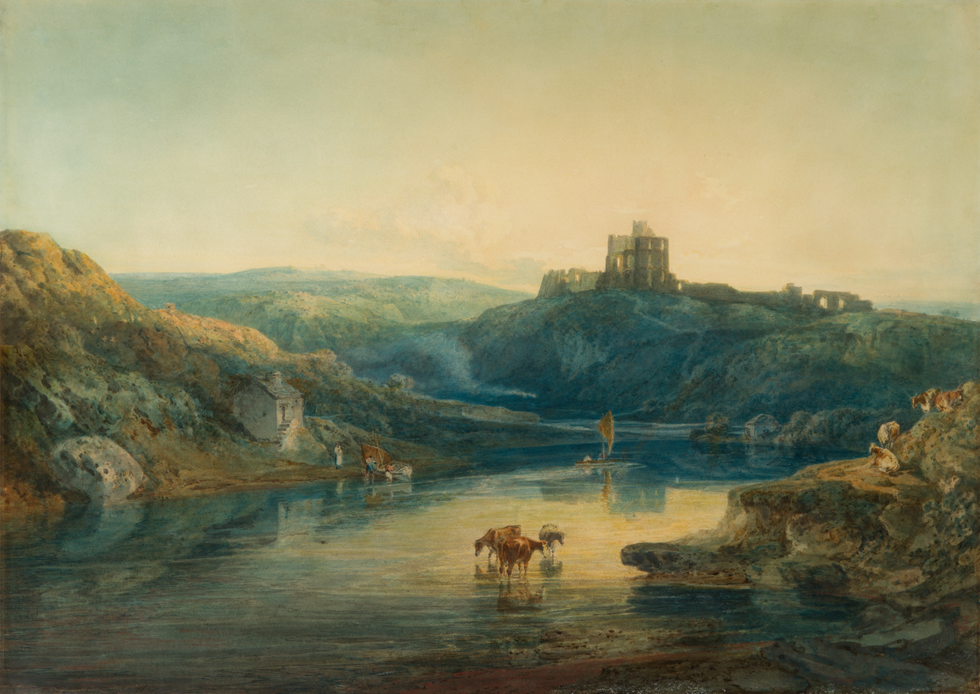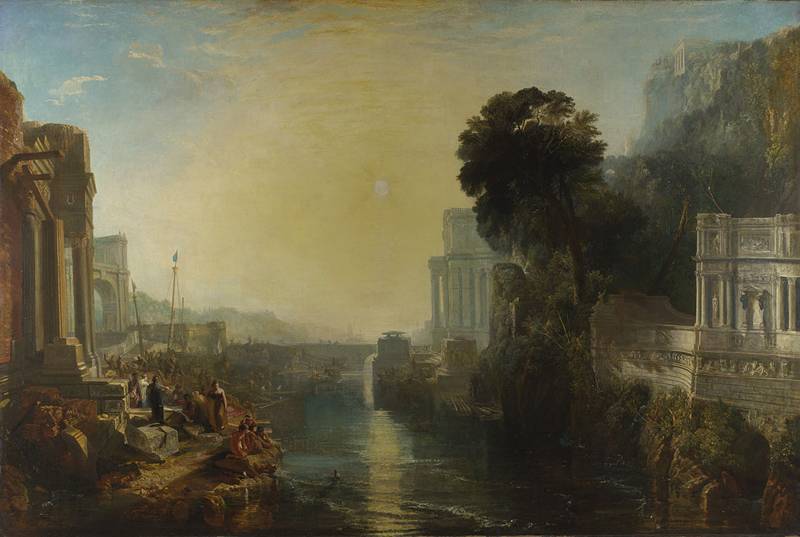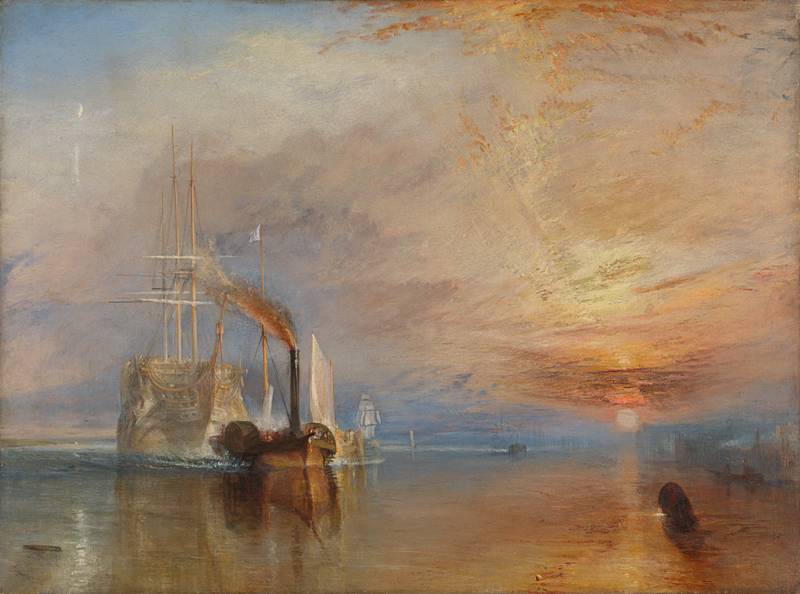J.M.W. Turner remains one of Britain’s most admired artists through his achievements in both oils and watercolours. At the beginning of the 19th century, he came to prominence at the same time as John Constable, John Crome, John Sell Cotman, Peter De Wint and David Cox, in an era when landscape as a genre was achieving a new status and significance. During a career of six decades as an exhibitor at the Royal Academy, Turner steadily maintained his dominant position among fellow British artists, despite his pursuit of experimental processes and new materials, coupled with his often-controversial adoption of brilliant colours and a style that became increasingly ‘indistinct’. Even before he entered the schools of the Royal Academy, at the precocious age of 14, he had been studying with various architects and topographers, mastering the skills of detailed draughtsmanship in watercolour. His earliest triumphs were reportedly exhibited in the windows of his father’s barber shop in London’s Covent Garden. But in 1790, the first of his watercolour exhibits appeared in the Academy’s spring show; and then six years later he began to submit works painted in oils. Thereafter there were only a few years right up to 1850, in which the annual exhibition did not feature something by him.
Turner’s assured and innovative use of watercolour, and the ambitious scale of his pictures in that medium, were the initial means by which he attracted the approbation of his peers and his first favourable reviews. For these works, he drew on material accumulated during summer tours of the remoter parts of England, Wales, and eventually Scotland. By the end of 1799, he was sufficiently respected to be elected as an Associate Royal Academician, a distinction that he seemingly commemorated in his Self-Portrait (Tate), one of his rare attempts at figure painting.

Just three years later, in 1802, he was fully admitted as one of only 40 Royal Academicians. Within months, he undertook the first of around 20 continental journeys, on that occasion touring the Alps before returning to Paris to study the masterpieces in the Louvre, augmented by those acquired during Napoleon’s victorious campaigns.
The conflict with France, which resumed in 1803, stimulated Turner to consider the nature of empires; particularly their origins and endings, culminating in a series of pictures inspired by the fate of ancient Carthage. He was simultaneously exploring the idyllic scenery bordering the Thames to the west of London, which he viewed through the prism of the classical poetry of Virgil or Ovid. Like some of his contemporaries, he experimented with plein air studies, even as he remained constant to the compositional prototypes of earlier landscape masters such as Claude Lorrain or Nicolas Poussin.

Beyond the Academy Turner’s topographical watercolours were highly prized, notably his views of the southern coast of England (1811–24), which were translated into commercially produced black and white line engravings that introduced his designs to a much wider audience. But he also created some of his most audaciously sublime views of the mountain gorges he had encountered on his Alpine journey.
The majority of these were acquired by Walter Fawkes, a landowner and former M.P., who lived at Farnley Hall, to the north of Leeds. Unlike many of the highly placed patrons who had supported Turner in the years around 1800, whose wealth was mired in the economy of the West Indies and enslavement, Fawkes was a campaigning abolitionist. Turner became a regular visitor to his Yorkshire home, touring the region, and making profitable connections for commissions from neighbouring collectors, such as Sir William Pilkington (Fawkes’s brother-in-law).
Fawkes eventually owned one of the largest groups of paintings and watercolours by Turner, including watercolours of Farnley Hall and its estate, various places in Italy and Switzerland, and the sequence of 50 Rhine scenes, as well as the great painting The Dort, or Dordrecht, Turner’s homage to Aelbert Cuyp (1818). His nearest rivals as collectors were Sir John Leicester of Tabley Hall; Lord Egremont of Petworth House; and subsequently the Scottish laird, H.A.J. Munro of Novar, who accompanied Turner on his alpine tour of 1836.
By the 1820s there had been a notable brightening to the palette range of Turner’s oil paintings. This can initially be traced back to his adoption of white grounds in the years before 1810, which introduced a luminosity comparable to the effects he was achieving in watercolour. Newly created pigments, such as chrome yellow, further paved the way for a kind of heightened realism in his landscapes, though this tendency began to attract sustained criticism.
This was also the period in which Turner was travelling most intensively, not only in Britain, but also encompassing Italy (1819 and 1828), Belgium and Luxembourg (1824 and 1839), the coast of western Brittany and Touraine (1826), Germany, Austria and Venice (1833 and 1840), Denmark and Bohemia (1835), as well as several tours of Switzerland (1836, 1841–44).
He explored Scotland when seeking landscape scenes for his collaborations with Sir Walter Scott (1822, 1831 and 1834). The success of Turner’s designs for two volumes of poetry by Samuel Rogers (1830 and 1834) further ensured commissions from other publishers, and the images were incidentally the means of introducing the young John Ruskin to Turner’s work.
Turner had always integrated aspects of contemporary life into his landscapes, including troops and sailors during the period of war with France, as well as scenes of turbulence in the years leading to electoral reform. More crucially, it is his representations of industrial change that remain some of his most potent pictures. In recording both Leeds and Dudley, he highlighted the discernible impact of smoke pollution on each setting. But elsewhere he appears to have been thrilled by the advances introduced by steam travel, whether on land (via the new railways) or on water. In his depiction of the veteran warship, the Temeraire (National Gallery), on its final voyage up the Thames, he constructed an image of ambiguities, apparently celebrating the majesty of the age of sail, while implying that steam technology would be the future.

Over the course of Turner’s career critical responses, which had always been divided, tipped more decidedly towards incomprehension and mockery, even though there were always advocates for the blurred style he pursued after the early 1830s. In describing the impression made on them by the physical appearance of the paint on Turner’s later works, reviewers made comparisons with all kinds of food stuffs, or suggested the canvases could be just as easily displayed upside down. The publication of Ruskin’s Modern Painters (1843–1860) challenged these prevailing criticisms, making a case for the truth of the artist’s images that had a lasting influence.
Turner died a wealthy man in 1851, just as British art was moving towards a more precise naturalism, growing out of the photographic aesthetic of the Pre-Raphaelites. The contents of his studio, including thousands of watercolours, drawings and sketchbooks, along with numerous unsold paintings (notably his ambitious classical narratives), were settled in 1856 as the Turner Bequest, and gradually absorbed into the national collection, first at the National Gallery, and later at the Tate Gallery, where a wing dedicated to Turner opened in 1987. Other notable groups of his works can be found at the Yale Center for British Art, New Haven; the National Galleries of Ireland and Scotland, which collectively house works by Turner from Henry Vaughan’s bequest of 1900; Petworth House, West Sussex; the British Museum, London; the Whitworth Art Gallery and Manchester City Art Gallery.
This article was written by Ian Warrell, Turner Scholar and former Curator of 18th and 19th Century British Art at the Tate.